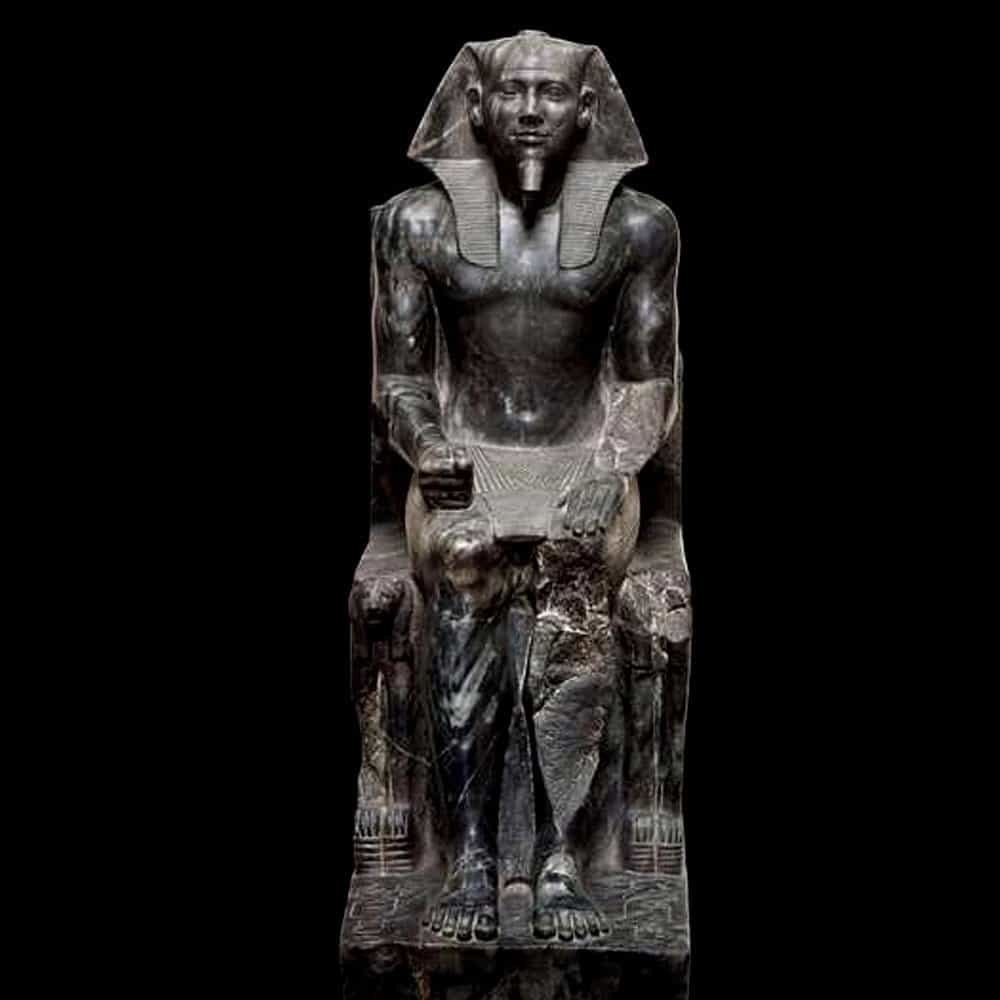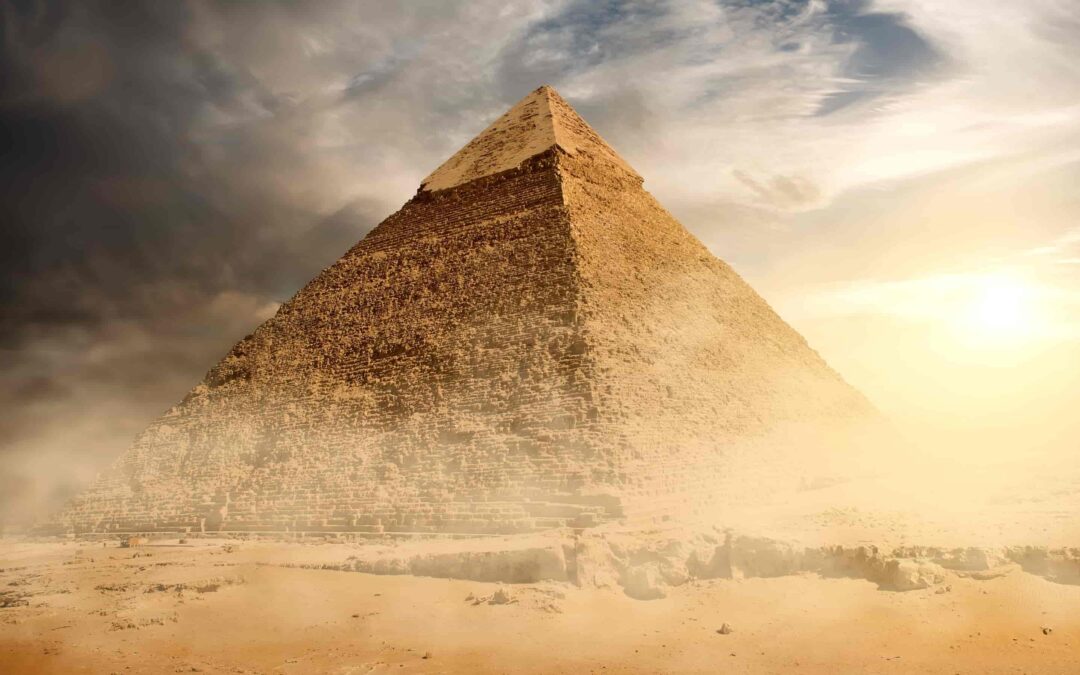The Pyramid of Khafre, standing as the second-largest pyramid at Giza, commands attention with its towering presence. Despite being smaller than the Pyramid of Khufu, it gives the illusion of greater size due to its strategic location on a higher plateau.
What makes this pyramid particularly distinct is that it’s the only one of the three still preserving a portion of its original limestone casing, a feature that once gave it a gleaming, polished appearance.
Located just 4 kilometers from modern Cairo, the Pyramid of Khafre is part of a legendary trio of monuments that define the ancient Giza necropolis. Alongside the pyramids of Khufu and Menkaure, it represents the eternal legacy of Egypt’s Fourth Dynasty.
These pyramids were constructed in less than a century during the Old Kingdom period and are considered one of the most remarkable architectural feats of the ancient world. Today, they remain iconic symbols of Egypt, earning recognition as a UNESCO World Heritage Site.
One notable feature of Khafre’s funerary complex is its well-preserved Valley Temple. This was the site where the pharaoh’s mummification process began, before his spirit was believed to ascend to the stars.
The temple and the pyramid, once fully covered in high-quality limestone sourced from the Tura quarries, would have appeared brilliantly smooth and reflective in the sun, a testament to the skill of ancient Egyptian builders.
Though often mistaken for the largest of the Giza pyramids due to its elevated position, Khafre’s pyramid is slightly smaller than the Pyramid of Khufu. However, the higher ground on which it stands gives it an imposing and majestic appearance, ensuring its enduring place in the skyline of ancient Egyptian grandeur.
Pharaoh Khafre
Khafre, son of Pharaoh Khufu and Queen Henutsen, became ruler of Egypt following the untimely death of his elder brother, Djedefre. His reign lasted roughly 25 or 26 years, from around 2547 to 2521 BC. His name, meaning “Ra exalts him,” reflects the close connection between the Egyptian monarchy and the sun god, Ra.
Despite his relatively long reign, little is definitively known about Khafre’s life and rule. One notable relic from his era is a stunning diorite statue, unearthed by archaeologist Auguste Mariette, which is often regarded as one of the finest artistic achievements of ancient Egypt.
For many years, Khafre’s pyramid was thought to be solid, lacking any internal burial chambers. However, in 1818, Italian explorer Giovanni Battista Belzoni made a breakthrough. After observing an unusual mound of debris on the north side of the pyramid, Belzoni and his team worked for 30 days to gain entry into the structure, which had long been considered impenetrable.
Upon entering, they discovered the central chamber. While there was no treasure, they found a pink granite sarcophagus, “buried on the ground.” Belzoni famously left his mark inside the pyramid with the inscription, “Discovered by G. Belzoni, March 2, 1818,” which can still be seen today.
It is now believed that the pyramid had already been opened centuries before Belzoni’s expedition, possibly around the year 1200, and then later resealed.
Khafre’s Funerary Complex
The funerary complex of Pharaoh Khafre stands as a quintessential example of Old Kingdom Egyptian architecture, showcasing the key elements typical of the necropolises of the Fourth Dynasty. These include the pharaoh’s pyramid, a mortuary temple adjoining the pyramid, a valley temple, and a ceremonial causeway that linked the two temples.
Khafre’s pyramid stands 143.5 meters tall and spans 215 meters at its base, making it only slightly shorter than his father Khufu’s pyramid by about three meters. However, despite covering less ground, the pyramid’s steeper angle and elevated position make it appear taller, and it remains one of the best-preserved pyramids of Giza.
Inside, the structure is simpler compared to Khufu’s pyramid, consisting of a passage leading to two interior chambers. The burial chamber’s ceiling is constructed with massive slanted granite blocks, and the pharaoh’s sarcophagus is situated almost at ground level.
The pyramid features two entrances on its north face: one positioned 12 meters above the ground, and another at the base, leading to a long interior corridor.
On the eastern side of the pyramid was the mortuary temple, though only remnants of it survive today. One notable fragment is a granite block weighing over 400 tons.
Originally, the temple was 110 meters long, featuring a grand vestibule supported by 14 columns and a rectangular hall that opened into a large, columned courtyard. To the north and south, trenches were dug to hold Khafre’s solar boats, symbolic vessels intended for his journey into the afterlife.
A 494-meter-long causeway connected the mortuary temple to the valley temple, which was discovered in 1852 by archaeologist Auguste Mariette and remains in remarkably good condition.
The valley temple is a striking structure, built from massive pink granite blocks quarried from Aswan. Its central hall, shaped like an inverted “T,” contains 16 four-meter-tall monolithic pillars.
The precision and harmony of the temple’s proportions make it a masterpiece of ancient construction. Originally, the walls were adorned with 23 statues of Khafre, crafted from diorite and alabaster. Today, only one remains, displayed in the Cairo Museum.
This temple was where key funerary rituals took place, including the purification of the pharaoh’s body and the “opening of the mouth” ceremony, which symbolically brought the statues of the pharaoh to life.
The mummification process occurred on the temple’s roof, accessible via staircases. Khafre’s internal organs were stored in canopic jars, which were placed in four of six elongated chambers at the southern end of the complex.
Once these ceremonies were completed, the funeral procession traveled along the causeway to the mortuary temple, where the embalmed body was finally laid to rest in the burial chamber of the pyramid, within a granite sarcophagus.





